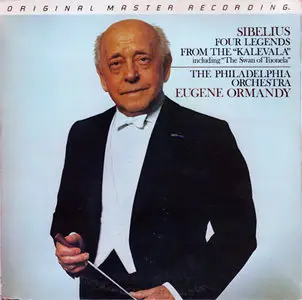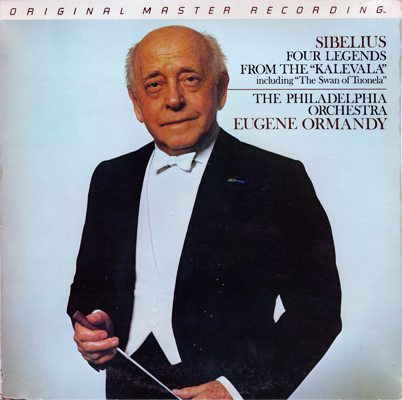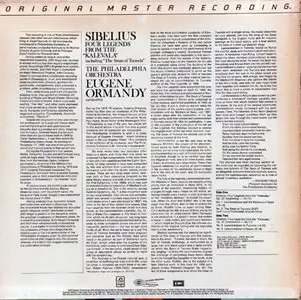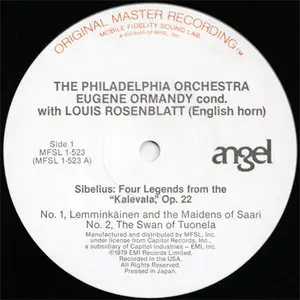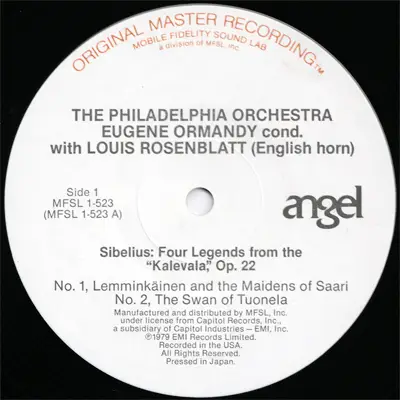Sibelius - Four Legends From The Kalevala, Op. 22
The Philadelphia Orchestra - Eugene Ormandy
FLAC | Artwork | 24Bit 96kHz: 871 MB | 16Bit 44.1kHz: 237 MB
Cat#: MFSL 1-523 | Country/Year: US 19__, 1979
Genre: Classical, Romantic | Hoster: Uploaded/Filesonic
MD5 [X] FFP [] CUE [] LOG [] INFO TEXT [X] ARTWORK [X]
webfind [] selfrip [X]
Info:
Sibelius / Philadelphia Orchestra, The / Eugene Ormandy – Four Legends From The "Kalevala", Op. 22
Label: Mobile Fidelity Sound Lab
Catalog#: MFSL 1-523
Format: Vinyl, LP, Album, Remastered, Reissue
Country: US
Released: ? (original recording released 1979)
Genre: Classical
Style:
Tracklist
A1 Lemminkäinen And The Maidens Of Saari
A2 The Swan Of Tuonela
B1 Lemminkäinen In Tuonela
B2 Lemminkäinen's Return
Credits
* Composed By – Jean Sibelius
* Conductor – Eugene Ormandy
* Design – Marvin Schwartz
* Engineer – John Kurlander
* English Horn – Louis Rosenblatt (tracks: A2)
* Orchestra – Philadelphia Orchestra, The
* Producer – John Willan
* Remastered By – Stan Ricker
Notes
Half-speed re-mastering of 1979 EMI/Angel title with Ortofon cutting head. Specially plated and pressed on High Definition Super vinyl by Victor Company of Japan.
Discogs Url: http://www.discogs.com/release/2513847
Jean Sibelius (8 December 1865 – 20 September 1957) was a Finnish composer of the later Romantic period whose music played an important role in the formation of the Finnish national identity. His mastery of the orchestra has been described as "prodigious."[1]
The core of Sibelius's oeuvre is his set of seven symphonies. Like Beethoven, Sibelius used each successive work to further develop his own personal compositional style. His works continue to be performed frequently in the concert hall and are often recorded.
In addition to the symphonies, Sibelius's best-known compositions include Finlandia, the Karelia Suite, Valse triste, the Violin Concerto in D minor and The Swan of Tuonela (one of the four movements of the Lemminkäinen Suite). Other works include pieces inspired by the Finnish national epic, the Kalevala; over 100 songs for voice and piano; incidental music for 13 plays; the opera Jungfrun i tornet (The Maiden in the Tower); chamber music; piano music; Masonic ritual music; and 21 separate publications of choral music.
Sibelius composed prolifically until the mid-1920s. However, after completing his Seventh Symphony (1924), the incidental music to The Tempest (1926), and the tone poem Tapiola (1926), he produced no large scale works for the remaining thirty years of his life. Although he is reputed to have stopped composing, he in fact attempted to continue writing, including abortive efforts to compose an eighth symphony. He wrote some Masonic music and re-edited some earlier works during this last period of his life, and retained an active interest in new developments in music, although he did not always view modern music favorably.
The Lemminkäinen Suite (also called the Four Legends, or Four Legends from the Kalevala) is a work written by the Finnish composer Jean Sibelius in the early 1890s which forms his opus 22. Originally conceived as a mythological opera, Veneen luominen (The Building of the Boat), on a scale matching those by Richard Wagner, Sibelius later changed his musical goals and the work became an orchestral piece in four movements. The suite is based on the character Lemminkäinen from the Finnish national epic, the Kalevala. The piece can also be considered a collection of symphonic poems. The third section, The Swan of Tuonela is often heard separately.
* Lemminkäinen and the Maidens of the Island: this is based on Runo 29 ("Conquests"), where Lemminkäinen travels to an island and seduces many of the women there, before fleeing the rage of the men on the island.
* Lemminkäinen in Tuonela: this is based on Runos 14 ("Elk, horse, swan") and 15 ("Resurrection"). Lemminkäinen is in Tuonela, the land of the dead, to shoot the Swan of Tuonela to be able to claim the daughter of Louhi, mistress of the Northland, in marriage. However, the blind man of the Northland kills Lemminkäinen, whose body is then tossed in the river and then dismembered. Lemminkäinen's mother learns of his death, travels to Tuonela, recovers his body parts, reassembles him and restores him to life.
* The Swan of Tuonela: this is the most popular of the four tone poems and often is featured alone from the suite in orchestral programs. It has a prominent English horn solo. The music paints a gossamer, transcendental image of a mystical swan swimming around Tuonela, the island of the dead. Lemminkäinen has been tasked with killing the sacred swan, but on the way he is shot with a poisoned arrow, and dies himself.
* Lemminkäinen's Return: the storyline in the score roughly parallels the end of Runo 30 ("Jack Frost"), where after his adventures in battle, Lemminkäinen journeys home.
The above order of the movements matches their numbering within opus 22. However, Sibelius revised the order in 1947, transposing the middle two movements, which is the order in which most concert performances are played.
The Philadelphia Orchestra is a symphony orchestra based in Philadelphia, Pennsylvania, in the United States. One of the "Big Five" American orchestras, it was founded in 1900. The orchestra's home is the Kimmel Center for the Performing Arts, where it performs its subscription concerts, numbering over 130, in Verizon Hall.
From 1900 to 2001, the Philadelphia Orchestra gave its concerts at the Academy of Music. The orchestra continues to own the Academy, and returns there one week per year that includes the Academy of Music's annual gala concert and concerts for school children. The Philadelphia Orchestra's summer home is the Mann Center for the Performing Arts. It also has summer residencies at the Saratoga Performing Arts Center, and since July 2007 at the Bravo! Vail Valley Festival in Vail, Colorado. The orchestra also performs an annual series of concerts at Carnegie Hall.
Since 2008, the orchestra's Chief Conductor is Charles Dutoit. Wolfgang Sawallisch, music director from 1993 to 2003, is the orchestra's Conductor Laureate. Yannick Nézet-Séguin is the orchestra's Music Director Designate, as of June 2010, and is scheduled to become the orchestra's eighth Music Director with the 2012–2013 season.
Eugene Ormandy (November 18, 1899 – March 12, 1985) was a Hungarian-born conductor and violinist.
Ormandy's 44-year tenure with the Philadelphia Orchestra began in 1936 and became the source of much of his lasting reputation and fame. Two years after his appointment as associate conductor under Leopold Stokowski, he became its music director. (Stokowski continued to conduct some concerts in Philadelphia until 1941; he returned as a guest conductor in 1960.) As music director, Ormandy conducted from 100 to 180 concerts each year in Philadelphia. Upon his retirement in 1980, he was made conductor laureate.
Ormandy was a quick learner of scores, often conducting from memory and without a baton. He demonstrated exceptional musical and personal integrity, exceptional leadership skills, and a formal and reserved podium manner in the style of his idol and friend, Arturo Toscanini.[citation needed] One orchestra musician complimented him by saying: "He doesn't try to conduct every note as some conductors do."[citation needed] Under Ormandy's direction the Philadelphia Orchestra continued the lush, legato style originated by Stokowski and for which the orchestra was well known. Ormandy's conducting style was praised for its opulent sound, but also was criticized for supposedly lacking any real individual touch.
Ormandy was particularly noted for conducting late Romantic and early 20th century music. He particularly favored Bruckner, Debussy, Dvorák, Ravel, Richard Strauss, Tchaikovsky, and transcriptions of Bach. His performances of Beethoven, Brahms, Haydn, and Mozart were considered less successful by some critics, especially when he applied the lush, so-called "Philadelphia Sound" to them. He was particularly noted as a champion of Sergei Rachmaninoff's music, conducting the premiere of his Symphonic Dances and leading the orchestra in the composer's own recordings of three of his piano concertos in 1939-40. He also directed the American premiere of several symphonies by Dmitri Shostakovich. He made the first recording of Deryck Cooke's first performing edition of the complete Mahler Tenth Symphony, which many critics praised. He also performed a great deal of American music and gave many premières of works by Samuel Barber, Paul Creston, David Diamond, Howard Hanson, Walter Piston, Ned Rorem, William Schuman, Roger Sessions, Virgil Thompson, and Richard Yardumian.
In 1947, Ormandy appeared in the feature film Night Song in which he conducted Leith Stevens' Piano Concerto, with Artur Rubinstein as soloist.
The Philadelphia Orchestra under Ormandy's direction frequently performed outside of Philadelphia, in New York and other American cities, and undertook a number of foreign tours. During a 1955 tour of Finland, Ormandy and many of the Orchestra's members visited the elderly composer Jean Sibelius at his country estate; Ormandy was photographed with Sibelius and the picture later appeared on the cover of his 1962 stereo recording of the composer's first symphony. During a 1973 tour of the People's Republic of China, the Orchestra performed to enthusiastic audiences that had been isolated from Western classical music for many decades.
Ormandy and the Philadelphia Orchestra, as well as smaller ensembles composed of its members, often collaborated with Richard P. Condie (and later Jerold Ottley) and the Mormon Tabernacle Choir to produce many recordings still considered definitive today, most notably the Grammy- winning recording of the Wilhousky arrangement of the Battle Hymn of the Republic.
After Ormandy officially retired as music director of the Philadelphia Orchestra in 1980, he served as a guest conductor of other orchestras and made a few recordings.
Ormandy died in Philadelphia on March 12, 1985. His papers, including his marked scores and complete arrangements, fill 501 boxes in the archives of the University of Pennsylvania Library. wikipedia
=Hardware=
LP>
Shure M97xE>
Dual CS 505-3>
Handcrafted low capacitance custom cables, teflon® insulated & silver-plated coaxial conductors>
Kenwood C1 Custom Revision I>
- Phono Stage input and RIAA equalisation capacitors replaced by Styroflex and Polypropylen types resp.
- Electrolytic capacitors not mounted by manufacturer onto the RIAA stage power Supply refitted (Philips NOS types)
- All electrolytic capacitors in signal chain replaced by foil capacitors
- All old JRC OpAmps replaced by Burr Brown (Phono Stage) and Analog Devices OpAmps resp.>
Handcrafted low capacitance custom cables, polyethylene insulated twinaxial conductors>
Audiotrak Prodigy 7.1 HiFi w/ AD712 OpAmps @ 24/96>
HDD
=Software=
Adobe Audition 3
ClickRepair
Trader´s Little Helper (FLAC)
+16Bit Version:
Weiss Saracon 01.61-27
Dither: POWr3
Date of rip: 2011-05-08
Please keep the info sheet included if you share this!
[Uploaded/250MB]
24Bit/96kHz Version
http://ul.to/072zohyg/FHQA-Si-FoLeOfThKa-24B.part1.rar
http://ul.to/jdk92vcf/FHQA-Si-FoLeOfThKa-24B.part2.rar
http://ul.to/acypg34d/FHQA-Si-FoLeOfThKa-24B.part3.rar
http://ul.to/fvoa6yff/FHQA-Si-FoLeOfThKa-24B.part4.rar
16Bit/44.1kHz Version
http://ul.to/oavrxhwt/FHQA-Si-FoLeOfThKa-16B.rar
Interchangeable Mirror:
[Filesonic/250MB]
24Bit/96kHz Version
http://www.filesonic.com/file/...QA-Si-FoLeOfThKa-24B.part1.rar
http://www.filesonic.com/file/...QA-Si-FoLeOfThKa-24B.part2.rar
http://www.filesonic.com/file/...QA-Si-FoLeOfThKa-24B.part3.rar
http://www.filesonic.com/file/...QA-Si-FoLeOfThKa-24B.part4.rar
16Bit/44.1kHz Version
http://www.filesonic.com/file/953801321/FHQA-Si-FoLeOfThKa-16B.rar
If you have problems extracting the RAR files on your HD, please verify these checksums. If they do not match, redownload the not-matching part and try again.
(copy & paste to your editor and save as *.md5 in the folder where the RAR files are located)
16Bit
359a2a712e401f2eba0e2bbce48a3ce7 *FHQA-Si-FoLeOfThKa-16B.rar
24Bit
eee718f8fc8b36768e36238e38587afa *FHQA-Si-FoLeOfThKa-24B.part1.rar
1bc6d3ddc2c4303515ef35914c90d161 *FHQA-Si-FoLeOfThKa-24B.part2.rar
d7636f28986193c4d089acbae77383c5 *FHQA-Si-FoLeOfThKa-24B.part3.rar
1a5d8a1b0f849ba1beb75041e2bdde6c *FHQA-Si-FoLeOfThKa-24B.part4.rar
Dynamic Range Analysis
–––––––––––––––––––––––––––––––––––––––––––––––
Analyzed folder: F:\=== VINYL RIPS ===\SibeliusMFSL\16Bit\
–––––––––––––––––––––––––––––––––––––––––––––––
DR Peak RMS Filename
–––––––––––––––––––––––––––––––––––––––––––––––
DR17 -1.16 dB -23.67 dB A1 - Lemminkäinen And The Maidens Of Saari.wav
DR14 -12.40 dB -32.63 dB A2 - The Swan Of Tuonela.wav
DR15 -1.17 dB -23.46 dB B1 - Lemminkäinen In Tuonela.wav
DR14 -4.47 dB -23.24 dB B2 - Lemminkäinen's Return.wav
–––––––––––––––––––––––––––––––––––––––––––––––
Number of files: 4
Official DR value: DR15
==============================================================================================


